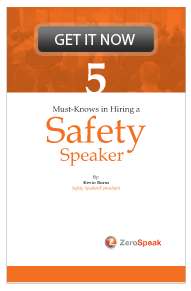Safety And The Unspoken Code

Never in history have there been more safety professionals in the workplace. Never in history have there ever been more certifications in safety. Never in history have the rules of the OH&S Act had more teeth. And yet, workplace incident numbers continue to rise. And there is a reason.
Broadcaster Gary Doyle recently wrote a post on traffic safety: "We have laws. We have rules, and we have the code. Following all three will get everybody home safe." He goes on the explain the Code: "It’s not the highway driving act you’re violating, it’s the 'code' of the road. There is the law, and there is the code of conduct."
Doyle's post brought to mind that in every workplace, there are three parts that must come together in order for safety to work:
- the laws that the company must abide by - OH&S Act
- the rules/procedures employees must follow - Corporate Safety Manual
- the way we do things 'round here - the Code
But The Most Powerful Of The Three
There is a battle for the hearts and minds of workers between the Act, the Manual and the unwritten Code. The Act is a blueprint that will translate into the Corporate Safety Manual. For employees though, they follow the Corporate Safety Manual. But what about the Code?
There is no question that the Act has the power to put employees and employers in jail or to fine them into bankruptcy for straying from it directives. But, it is not the most powerful influence on the job day-to-day. Neither are the Corporate Safety Manual's procedures and rules of operation. Flaunt the procedures from the safety manual and the worst that can happen is to be fired but more likely reprimanded for not following procedure. No, the one that has the most power over employees is the unspoken Code of how we do things 'round here - how you will fit in and get along with your peers.
Understanding The Code
Fitting in is unspoken pressure. Being accepted and liked are powerful motivators. People don't want to look stupid at work so they watch how things work observing: who defers to whom, who is the unnamed leader - the Alpha dog, who are the influencers and how the group collectively thinks about and treats the supervisors and bosses.
With the Code, there is no formal organization but there is an expectation of order and compliance. There are no written rules but there are unspoken guidelines that you will not do anything to upset the balance. In other words, head down, fit in, do your work and think within the Code. Follow the rest of the group.
Culture And The Code
Companies try to shift corporate safety culture without taking into account the existence of the Code. When employers don't communicate, don't include employees in discussions about the culture of safety or attempt to arbitrarily push a new safety culture initiative onto the employees, they will become frustrated by a lack of employee compliance. That's because the Code is more powerful than culture. The Code creates and controls the culture. And because the Code is what keeps the employees functioning together, getting people to step outside of their Code is an exercise in futility.
Where Will You Expend Your Energy?
Culture is never top-down. It is always bottom-up. Culture is the result of what happens when rules and procedures meet the Code. New culture initiatives get eaten alive by the existing culture if you don't account for the Code. To shift culture, you've got to get through the Code.
Pushing the Corporate Safety Manual onto your employees in an attempt to get compliance means you're working in the wrong place. The rules and procedures are important but if they don't line up with the Code, compliance exercises will frustrate. The Code is a better illustration of true compliance. Peer-to-peer is more influential than top-down.
Compliance Or Safety
You can either choose to improve compliance or improve the safety record. Do you want your people to blindly obey or to be incident-free? The first choice requires top-down policing. The second involves inspiring users of the Code to become accountable in their own workplace safety. In other words, you're selling your safety initiative to users of the Code. They may already work together. You just have to make them fit together.
As an outside resource who helps companies sell the idea of safety to their employees, my clients have said that I have the ability to say things that need saying in a way they couldn't say it. Consider hiring me to address your followers of the Code and help find a way to line up your Manual with the Code. In the meantime click below to download the e-book 5 Must Knows In Hiring A Safety Speaker.



